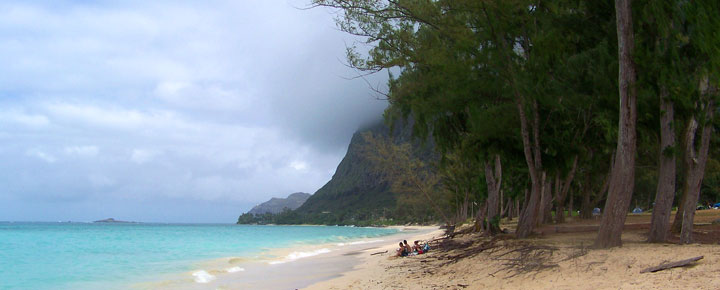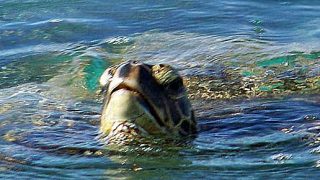Snakes in Hawaii? Hawaii is renowned for its pristine beaches, unique wildlife, and absence of native snake populations. However, recent incidents have sparked discussions about the presence of snakes in the islands, which can impact both visitors and residents.


Yellow-bellied sea snake at Waimanalo Beach.
Three days ago, a yellow-bellied sea snake was found washed ashore at Waimanalo Beach on Oahu. Experts from the Waikiki Aquarium identified it as a rare occurrence, likely due to recent high winds and tides. The yellow-bellied sea snake, typically found in the tropical Pacific, is known for its distinctive yellow underside and dark upper body. While sea snakes are generally not aggressive, they are venomous and carry a potent neurotoxin, posing potential risks to humans.


Sea Snake reported at Wailea Beach, Maui.
Another sea snake sighting was reported at Wailea Beach, Maui, on July 7, when a visitor came running out of the ocean while BOH editors were there, claiming she had just seen one. We didn’t think much of it until the recently confirmed report at Waiminalo. This incident emphasizes the need for awareness among beachgoers. And the importance of understanding these marine reptiles, their behavior, and any associated risks.
More about sea snakes in Hawaii.
The yellow-bellied sea snake, while rare, does occasionally turn up in the waters around Hawaii, as is clear from two sightings in the past two weeks. These are nonetheless uncommon and typically result from ocean currents and high winds that wash them ashore.
The yellow-bellied sea snake is easy to spot due to its vivid yellow underside. Although considered venomous, these snakes are generally not aggressive towards humans. Sightings near shore are infrequent because they prefer to stay offshore in warmer waters, making beach encounters even more unusual.
From our own half-century of experience, this was a first. While we’ve known about them for years and written about them before, this was our first encounter. We probably wouldn’t have even given it much thought had it not been for the subsequent Waimanalo Beach incident.
If you encounter a yellow-bellied sea snake, it is essential to maintain a safe distance and report the sighting to local authorities. This ensures public safety and the protection of Hawaii’s delicate ecosystem from potential threats posed by these and other non-native species.
Other Hawaii snake incidents.
Ball Python was found in April.
This snake was found in a Waipahu home during a wellness check. Native to Africa, these non-venomous snakes are quite common in the pet trade. The Hawaii Department of Agriculture, Plant Quarantine Branch, took the snake into custody.
Gopher Snake found last year.
In 2023, a non-venomous gopher snake was found in upcountry Maui. These are native to North America and are renowned for their role in controlling rodent populations. Their presence in Hawaii, however, is unnatural and potentially disruptive to our other wildlife.
Impact of non-native snakes in Hawaii.
Non-native snakes can profoundly affect Hawaii’s remote and delicate ecosystem. It’s been over twenty years since a period when eight Brown tree snakes were found in Hawaii. That could have led to significant issues for the native bird population and our native flora. Fortunately, there have been no sightings since then, and they are not considered established here.
According to the Hawaii Invasive Species Council, “a new assessment by the USDA National Wildlife Research Center puts the actual cost of BTS (Brown Tree Snake) at $1.7 billion per year if introduced to Hawai’i.”
Hawaii’s preventative measures.
To combat the threat of non-native snake introductions, Hawaii has stringent regulations and proactive measures. The Hawaii Department of Agriculture conducts regular inspections and has a rapid response team for snake sightings. Public awareness campaigns educate both residents and visitors about the risks and legal implications of bringing snakes to the islands.
Expert Insight
“Sea snakes, thought to be the most abundant venomous reptiles on the planet, are found in the warm, tropical waters of the Indian and Pacific Oceans but not in the Atlantic Ocean. There are 57 known species of sea snakes and two major subfamilies (Laticaudinae and Hydrophiinae). Sea snakes are not aggressive, although they have been known to bite humans in self-defense or when surprised; this most commonly occurs when fishermen attempt to remove them from fishing nets.”
NIH – National Library of Medicine.
While Hawaii remains largely snake-free, recent sightings highlight that we are not 100% snake-free. Understanding the implications of non-native species can help protect Hawaii’s unique environment. For more detailed information, read the original article on snakes in Hawaii.
Get Breaking Hawaii Travel News







Flying has become less enjoyable. I have been traveling for business for the last three years. Money money money… it’s a rich man’s game! More narrow body means more checked bags or bags ramp checked which increases time to get to a tight connection. Only option recently for two AA flights out of Charlotte were 38 minutes or less. Any delay and you may miss your connecting flight. Then you are stranded in Charlotte with a hotel bill and missed plans. I can’t wait for more direct flights from Tampa on Breeze!! Hey Breeze are you reading this!!??!!
The sea snakes, I understand are caused by elements of nature. But the snakes that are smuggled in. Those people should be fined so severely. Not slapped on the wrist for $50 bucks. Gosh darn it, you have enough to deal with without this type of crap that will destroy so much that we have taken for granted. I am so very sorry to read of these varmits on islands! When will we Stop worrying about offending others and stand up to this! Book em DanO!
We started coming to Hawaii in ‘86, from the very beginning it was billed as being snakeless, now, it appears contraband snakes have been introduced, and the Sea Snakes, were just something no one talked about. That said, it’s almost bizarre that as Tourism is compromised by the States Management choices, that was present before the August 2023 tragedy in Lahaina, which itself had State and County culpable with Power, Water, out-dated equipment, and the failure to implement changes Boards had recommendations for, 7-10 years earlier. The vast majority of us, don’t like snakes, given the political climate in ‘One Party’ Hawaii, just another reason to not spend the money there. Sad, like the rest, this was correctible..